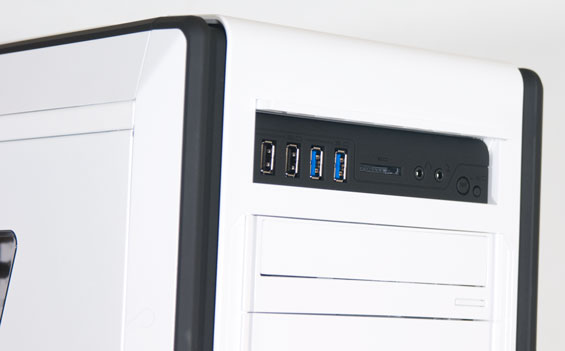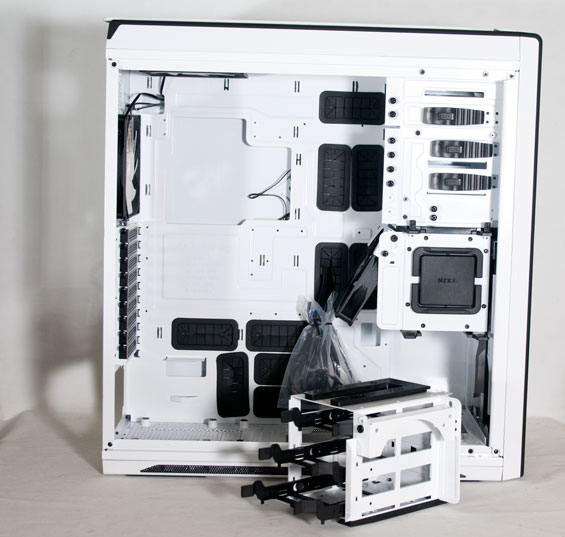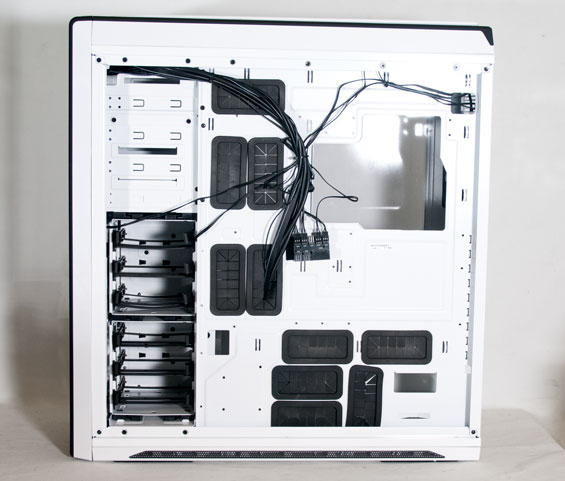NZXT Switch 810: When Too Much Isn't Enough
by Dustin Sklavos on February 1, 2012 7:00 AM EST- Posted in
- Cases/Cooling/PSUs
- NZXT
- Full-Tower
- Switch
In and Around the NZXT Switch 810
When you get it out of the box and eyeball it, the NZXT Switch 810 really does come off as a fairly sleek and attractive design. It's a little flashier than most, but it's not over-the-top Stormtrooper-style like the Phantom; the Switch is just distinctive. Our review unit is a two-toned white-on-black unit, but you can also get it in black-on-black if you want something a little less eye-catching.

Starting at the front, NZXT includes easily removable drive bay shields (one of which is an optical drive bezel that actually lines up with the drive we use for testing--nice!), a single 3.5" hotswap bay, and at the very top behind a cover, the case's I/O cluster featuring two USB 3.0 ports, two USB 2.0 ports, the standard mic and headphone jacks, the reset button, and two other welcome features: an integrated SD card reader and the button for toggling the rear LEDs on and off. The bottom of the fascia can also be popped off, revealing the two fan mounts.

The top of the Switch 810 includes the removable vent, the power switch, and the HDD activity and power lights, both illuminated with white LEDs. The vent is a nice enough touch similar to what we saw in Rosewill's Thor v2, but on the Switch 810 there's actually ventilation around it that allows the top exhaust fan to still expel air while the vent is closed.
When we look at the back, there are the usual four rubber-lined holes for routing water-cooling hosing (arguably even less important in a case like the Switch 810 that can house up to a combined 980mm worth of radiators internally), nine ventilated expansion slots, and the power supply bay. You'll notice the rear 140mm fan is also adjustable; loosen the screws and you can slide it up and down or even out of the existing notches and move it higher or lower.

NZXT includes a windowed side panel with the Switch 810 and the window's angle matches up to the angles on the top of the enclosure. The side panels are both held on with three thumbscrews, but they're not as secure as I'd like: the panels hinge outward, but they're easy to rattle in place and though I didn't experience any problems with it in use, I still don't like seeing side panels that loose.
Open the case and you'll find plenty of real estate. The two hard drive cages are both easily removable, and while they're lateral the drive sleds actually slide out behind the motherboard tray instead of above it. You can also see two adjustable fan mounts (one of which is populated) attached to the drive cages and used for directing airflow inside the enclosure. There are plenty of rubber-lined routing holes in the motherboard tray, and the power supply sits on top of a set of rubber pegs. NZXT uses a toolless mount for the open 5.25" drive bays, and the clasps are very sturdy.

The use of plastic everywhere isn't ideal, but the Switch 810 is definitely sturdier than Rosewill's case. Where customizability is concerned NZXT has definitely made their enclosure as accommodating as possible, but at this point you'll notice an omission that's going to rear its ugly head later: there's no fan controller. There's a set of fan headers behind the motherboard tray, but no actual fan control.
















29 Comments
View All Comments
Zstream - Wednesday, February 1, 2012 - link
That has better noise control?TerdFerguson - Wednesday, February 1, 2012 - link
Looking at the construction materials, design, etc, I just don't understand how this needs to be selling at $170. Is the price set merely to differentiate from other products? Can't some researcher actually find out what it costs to manufacture such a case? THAT is what I'd like to read. Ditto for motherboards.Morg. - Wednesday, February 1, 2012 - link
Speaking about the price tag ... Why not get a HAF X instead ? I mean there's a bunch of more interesting features, better cooling ... I think NZXT missed the point with this one.And on the other hand .. you can get so much quieter with other cases/. meh.
domezone - Saturday, February 4, 2012 - link
Attempting to justify price tags on logical points such as material costs as well as labor costs is illogical. Any amount of overhead or other middle men taking a cut will raise the price. Beyond a middle man and direct from the manufacture still leaves an overly inflated price point. This is not just for this product unfortunately, I wouldn't assume there are many products or services that actually cost what it costs the company + small amounts of profit.Though if you had questioned a company *any amount of questioning before breaking an arm off in court* the costs would be directly based on employee wages and materials with very modest markups. Guess the research and development costs need to be offset so a computer case set the company back $170 per unit....
no grammar hawks please I know I make errors
cjs150 - Wednesday, February 1, 2012 - link
This is a case designed for watercooling rigs. Massive room up top, and only a little bit of changing allows for a radiator in bottom.The lack of fan control is not a major issue. Lots of motherboards have built in fan control and if all else fails buy a separate controller - not exactly expensive.
My problem with this is simply that it is overpriced and nothing original. Simply example. If case is 235mm wide, would it be better to instal the PSU at tight angles (Lian Li have tried this) rather than conventionally? Makes for neating wiring.
I wonder if NZXT will follow with a smaller case (Switch 610 maybe)
danchen - Wednesday, February 1, 2012 - link
storm trooper !Iketh - Tuesday, February 7, 2012 - link
+1danacee - Wednesday, February 1, 2012 - link
I do not know why they insist upon mounting the PSU on the bottom sucking off the ground, but like bottom mounted freezers on trendy fridges and flat keyboards; it is moronic.Obviously just another cheap ploy to rip off Apple's Powermac and Mac Pro, who unlike these stupid asinine idiot me too PSU case makers; keep the PSU from sucking dirt off the ground and blowing up.
Impulses - Wednesday, February 1, 2012 - link
I believe the idea is to keep it away from the hotter areas (CPU/mem), since hot air rises anyway... Most cases have bottom filters and many users simply don't plant their cases on the floor.I'm not saying I agree with that logic, on a gamer's case the bottom location is bound to be as warm as anywhere else due to the GPU(s), although GPU are under load less often than the CPU (unless the system's used strictly for gaming).
It does seem odd to me that bottom PSU placement is almost universally favored now considering its sometimes a wash as far as temps and it can complicate wiring, but maybe I'm just rationalizing.
Impulses - Wednesday, February 1, 2012 - link
Personally I really dig Silverstone's 90 degree designs, but I haven't gotten around to trying one of them first hand. They're not the most flexible, since they complicate cable management even more and they're not really efficient if you're not using high powered or back vented GPUs, but for a gaming case it seems like the ideal solution... Kind of what BTX should've been.